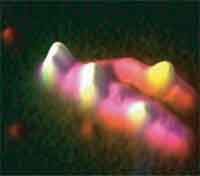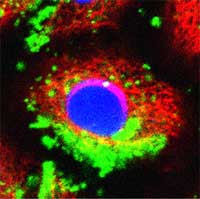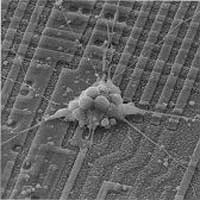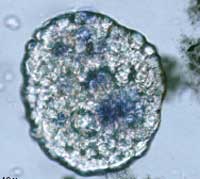Showing Spotlights 481 - 488 of 559 in category All (newest first):
 In the medical field there is a huge demand for tissue regeneration technologies, which covers a wide range of potential applications in such areas as cartilage, vascular, bladder and neural regeneration. Just consider the need for bone and dental implants: Each year, almost 500,000 patients receive hip implants worldwide, about the same number need bone reconstruction due to injuries or congenital defects and 16 million Americans loose teeth and may require dental implants. The market for medical implant devices in the U.S. alone is estimated to be $23 billion per year and it is expected to grow by about 10% annually for the next few years. Unfortunately, medical implant devices have been associated with a variety of adverse reactions, including inflammation and fibrosis. It has been suggested that poor tissue integration is responsible for loosening of implants and mechanical damage to the surrounding host tissues. Based on an expanding body of biomedical nanotechnology research work, there is a growing consensus among scientists that nanostructured implant materials may have many potential advantages over existing, conventional ones. The key, as indicated in a number of findings, seems to be that physical properties of materials, especially with regard to their surface's nanostructure, affect cell attachment and eventually the tissue response to the implant. Although nanotopography mediated cell responses have been shown in previous work, the mechanism of these responses is mostly undetermined. New research has now been conducted to determine the influence of nanopore size on cellular responses. Interestingly, these studies have revealed that larger nanopores (200 nm) trigger DNA replication and cell proliferation via various signal transduction pathways.
In the medical field there is a huge demand for tissue regeneration technologies, which covers a wide range of potential applications in such areas as cartilage, vascular, bladder and neural regeneration. Just consider the need for bone and dental implants: Each year, almost 500,000 patients receive hip implants worldwide, about the same number need bone reconstruction due to injuries or congenital defects and 16 million Americans loose teeth and may require dental implants. The market for medical implant devices in the U.S. alone is estimated to be $23 billion per year and it is expected to grow by about 10% annually for the next few years. Unfortunately, medical implant devices have been associated with a variety of adverse reactions, including inflammation and fibrosis. It has been suggested that poor tissue integration is responsible for loosening of implants and mechanical damage to the surrounding host tissues. Based on an expanding body of biomedical nanotechnology research work, there is a growing consensus among scientists that nanostructured implant materials may have many potential advantages over existing, conventional ones. The key, as indicated in a number of findings, seems to be that physical properties of materials, especially with regard to their surface's nanostructure, affect cell attachment and eventually the tissue response to the implant. Although nanotopography mediated cell responses have been shown in previous work, the mechanism of these responses is mostly undetermined. New research has now been conducted to determine the influence of nanopore size on cellular responses. Interestingly, these studies have revealed that larger nanopores (200 nm) trigger DNA replication and cell proliferation via various signal transduction pathways.
Aug 28th, 2007
 Vaccination has resulted in the eradication of smallpox and control of measles, rubella, tetanus, diphtheria, and other infectious diseases in many areas of the world (at least where vaccines are available and affordable; providing vaccines to many parts of the developing world still is one of the basic medical needs that is far from being met). The basic idea of vaccination (the word comes from the Latin vacca - cow - because the first vaccine was derived from a virus affecting cows) is to inject weakened or killed forms of pathogens such as bacteria or viruses into the body in order for the immune system to develop antibodies against them; if the same types of microorganisms enter the body again, they will be destroyed by the antibodies. About 25 years ago, the basic idea of vaccination gave rise to bactofection - the technique of using bacteria as non-viral gene carriers into target cells. The DNA cargo is transported inside the bacteria and, once it arrives at the target location, the bacteria is broken up in order to release the therapeutic gene or protein. A novel technique takes advantage of the invasive properties of bacteria for delivery of nanoparticles into cells. Here, the gene or cargo is not carried inside the bacteria, but rather remains on the surface conjugated to nanoparticles. Consequently, this approach does not require bacterial disruption for delivery, or any genetic engineering of the bacteria for different cargo.
Vaccination has resulted in the eradication of smallpox and control of measles, rubella, tetanus, diphtheria, and other infectious diseases in many areas of the world (at least where vaccines are available and affordable; providing vaccines to many parts of the developing world still is one of the basic medical needs that is far from being met). The basic idea of vaccination (the word comes from the Latin vacca - cow - because the first vaccine was derived from a virus affecting cows) is to inject weakened or killed forms of pathogens such as bacteria or viruses into the body in order for the immune system to develop antibodies against them; if the same types of microorganisms enter the body again, they will be destroyed by the antibodies. About 25 years ago, the basic idea of vaccination gave rise to bactofection - the technique of using bacteria as non-viral gene carriers into target cells. The DNA cargo is transported inside the bacteria and, once it arrives at the target location, the bacteria is broken up in order to release the therapeutic gene or protein. A novel technique takes advantage of the invasive properties of bacteria for delivery of nanoparticles into cells. Here, the gene or cargo is not carried inside the bacteria, but rather remains on the surface conjugated to nanoparticles. Consequently, this approach does not require bacterial disruption for delivery, or any genetic engineering of the bacteria for different cargo.
Aug 14th, 2007
 The question if certain engineered nanoparticles are toxic, and if yes to what degree, is still one of the major issues that hasn't been properly answered yet. Most studies in the literature thus far have focused on the environmental aspects of nanoparticle toxicity, and these studies have been conducted primarily on industrial or natural/incidental nanoparticles. However, engineered nanoparticles are at the forefront of the rapidly developing field of nanomedicine; and here they are deliberately injected into the body to perform a specific medical application: fluorescent agents for imaging; drug delivery vehicles; or therapeutic agents for the destruction of cancer cells (for instance in thermolysis); just to name a few. A brand new review article provides the first comprehensive summary of the properties of engineered nanoparticles which determine their interaction with components of the immune system. It concludes that nanoparticle-based therapeutics are no more intrinsically immunotoxic than traditional pharmaceuticals, such as biotechnology-derived or small molecules. Moreover, incorporation of traditional drugs into nanotechnology formulations frequently results in a decrease in immunotoxicity compared to the native drug. Although many questions still require thorough investigation, the available data suggest that nanoparticles can be engineered to become the next generation of biocompatible drug delivery platforms.
The question if certain engineered nanoparticles are toxic, and if yes to what degree, is still one of the major issues that hasn't been properly answered yet. Most studies in the literature thus far have focused on the environmental aspects of nanoparticle toxicity, and these studies have been conducted primarily on industrial or natural/incidental nanoparticles. However, engineered nanoparticles are at the forefront of the rapidly developing field of nanomedicine; and here they are deliberately injected into the body to perform a specific medical application: fluorescent agents for imaging; drug delivery vehicles; or therapeutic agents for the destruction of cancer cells (for instance in thermolysis); just to name a few. A brand new review article provides the first comprehensive summary of the properties of engineered nanoparticles which determine their interaction with components of the immune system. It concludes that nanoparticle-based therapeutics are no more intrinsically immunotoxic than traditional pharmaceuticals, such as biotechnology-derived or small molecules. Moreover, incorporation of traditional drugs into nanotechnology formulations frequently results in a decrease in immunotoxicity compared to the native drug. Although many questions still require thorough investigation, the available data suggest that nanoparticles can be engineered to become the next generation of biocompatible drug delivery platforms.
Aug 2nd, 2007
 Recent developments in spectroscopic techniques allow highly sensitive image detection both in vitro and in vivo on the individual cell level. These methods depend on nanometer-size particles as detection probes. One class of such particles, so-called nanocrystals or quantum dots (qdots), is very popular for constructing detection probes for biolabeling. Scientists have discovered that these nanocrystals can enable researchers to study cell processes at the level of a single molecule and may significantly improve the diagnosis and treatment of diseases such as cancers. Qdots are either used as active sensor elements in high-resolution cellular imaging, where the fluorescence properties of the qdots are changed upon reaction with the analyte, or in passive label probes where selective receptor molecules such as antibodies have been conjugated to the surface of the dots. Qdots could revolutionize medicine. Unfortunately, most of them are toxic. Ironically, the existence of heavy metals in qdots such as cadmium, a well-established human toxicant and carcinogen, poses potential dangers especially for future medical application, where qdots are deliberately injected into the body. As the use of nanomaterials for biomedical applications is increasing, environmental pollution and toxicity have to be addressed, and the development of a non-toxic and biocompatible nanomaterial is becoming an important issue. Researchers are now proposing the use of nanoscale diamond particles as a non-toxic alternative to heavy metal qdots.
Recent developments in spectroscopic techniques allow highly sensitive image detection both in vitro and in vivo on the individual cell level. These methods depend on nanometer-size particles as detection probes. One class of such particles, so-called nanocrystals or quantum dots (qdots), is very popular for constructing detection probes for biolabeling. Scientists have discovered that these nanocrystals can enable researchers to study cell processes at the level of a single molecule and may significantly improve the diagnosis and treatment of diseases such as cancers. Qdots are either used as active sensor elements in high-resolution cellular imaging, where the fluorescence properties of the qdots are changed upon reaction with the analyte, or in passive label probes where selective receptor molecules such as antibodies have been conjugated to the surface of the dots. Qdots could revolutionize medicine. Unfortunately, most of them are toxic. Ironically, the existence of heavy metals in qdots such as cadmium, a well-established human toxicant and carcinogen, poses potential dangers especially for future medical application, where qdots are deliberately injected into the body. As the use of nanomaterials for biomedical applications is increasing, environmental pollution and toxicity have to be addressed, and the development of a non-toxic and biocompatible nanomaterial is becoming an important issue. Researchers are now proposing the use of nanoscale diamond particles as a non-toxic alternative to heavy metal qdots.
Jul 30th, 2007
 Inhalation, or respiratory, therapy is a fairly old discipline of medicine that dates back to ancient times (and not always for purely therapeutic effects; witness the hookah). In the late 18th century, earthenware inhalers became popular for the inhalation of air drawn through infusions of plants and other ingredients and about 50 years ago the first pressurized metered dose inhaler was put on the market. Especially people suffering from asthma are very familiar with inhalers - devices that help deliver a specific amount of medication to the lungs. The delivery of drugs via the pulmonary route is a potentially effective form of therapy not only for asthma but also for for patients with other chronic diseases, including the debilitating hereditary disease, cystic fibrosis, type I diabetes (insulin is absorbed well through the lungs), and recently lung cancer. During inhalation therapy the drugs are delivered in aerosol form, meaning that very small particles of the drug are suspended in air (liquid particles make mist, solid particles make fume or dust). Unfortunately, state the-of-the-art aerosol delivery technologies do not allow to target aerosols to specific regions of the lung. Researchers in Germany now have show that aerosols containing magnetic nanoparticles can be guided inside the lungs and thus offer a potential new route for lung cancer treatment.
Inhalation, or respiratory, therapy is a fairly old discipline of medicine that dates back to ancient times (and not always for purely therapeutic effects; witness the hookah). In the late 18th century, earthenware inhalers became popular for the inhalation of air drawn through infusions of plants and other ingredients and about 50 years ago the first pressurized metered dose inhaler was put on the market. Especially people suffering from asthma are very familiar with inhalers - devices that help deliver a specific amount of medication to the lungs. The delivery of drugs via the pulmonary route is a potentially effective form of therapy not only for asthma but also for for patients with other chronic diseases, including the debilitating hereditary disease, cystic fibrosis, type I diabetes (insulin is absorbed well through the lungs), and recently lung cancer. During inhalation therapy the drugs are delivered in aerosol form, meaning that very small particles of the drug are suspended in air (liquid particles make mist, solid particles make fume or dust). Unfortunately, state the-of-the-art aerosol delivery technologies do not allow to target aerosols to specific regions of the lung. Researchers in Germany now have show that aerosols containing magnetic nanoparticles can be guided inside the lungs and thus offer a potential new route for lung cancer treatment.
Jul 27th, 2007
 Just a few days ago we ran a Spotlight on nanobionics that addressed some of the issues of bridging the interface between electronics and biology. Today we'll take a look at some leading edge research in the field of neural engineering - an emerging discipline that uses engineering techniques to investigate the function and manipulate the behavior of the central or peripheral nervous systems. Neural engineering is highly interdisciplinary and relies on expertise from computational neuroscience, experimental neuroscience, clinical neurology, electrical engineering and signal processing of living neural tissue, and encompasses elements from robotics, computer engineering, neural tissue engineering, materials science, and nanotechnology. In order for neural prostheses to augment or restore damaged or lost functions of the nervous system they need to be able to perform two main functions: stimulate the nervous system and record its activity. To do that, neural engineers have to gain a full understanding of the fundamental mechanisms and subtleties of cell-to-cell signaling via synaptic transmission, and then develop the technologies to replicate these mechanisms with artificial devices and interface them to the neural system at the cellular level. The first steps toward precise, informative and biocompatible neural interfaces have been made already.
Just a few days ago we ran a Spotlight on nanobionics that addressed some of the issues of bridging the interface between electronics and biology. Today we'll take a look at some leading edge research in the field of neural engineering - an emerging discipline that uses engineering techniques to investigate the function and manipulate the behavior of the central or peripheral nervous systems. Neural engineering is highly interdisciplinary and relies on expertise from computational neuroscience, experimental neuroscience, clinical neurology, electrical engineering and signal processing of living neural tissue, and encompasses elements from robotics, computer engineering, neural tissue engineering, materials science, and nanotechnology. In order for neural prostheses to augment or restore damaged or lost functions of the nervous system they need to be able to perform two main functions: stimulate the nervous system and record its activity. To do that, neural engineers have to gain a full understanding of the fundamental mechanisms and subtleties of cell-to-cell signaling via synaptic transmission, and then develop the technologies to replicate these mechanisms with artificial devices and interface them to the neural system at the cellular level. The first steps toward precise, informative and biocompatible neural interfaces have been made already.
Jul 24th, 2007
 In case you are not old enough to remember the TV series The Six Million Dollar Man during the 1970s, the show was about an astronaut, Steve Austin, who got severely injured during a crash and became a guinea pig for bionics experiments by the CIA. In an operation that cost six million dollars, his right arm, both legs and the left eye are replaced by bionic (cybernetic) implants that vastly enhanced his strength, speed and vision. Never mind Hollywood, though, but bionics - a word formed from biology and electronics - has become a serious research field. In particular the development of artificial muscles is progressing rapidly. Nature's solution to producing fast contracting muscles is to use nanotechnology. The challenge for scientists is to mimic the intricacy of natural muscle in their artificial-muscle systems. As material scientists and engineers delve into the nanodomain, the boundaries between electronics and biology become fuzzy and this is exactly what they want: a seamless transition between the hard world of electronics and the soft world of biology.
In case you are not old enough to remember the TV series The Six Million Dollar Man during the 1970s, the show was about an astronaut, Steve Austin, who got severely injured during a crash and became a guinea pig for bionics experiments by the CIA. In an operation that cost six million dollars, his right arm, both legs and the left eye are replaced by bionic (cybernetic) implants that vastly enhanced his strength, speed and vision. Never mind Hollywood, though, but bionics - a word formed from biology and electronics - has become a serious research field. In particular the development of artificial muscles is progressing rapidly. Nature's solution to producing fast contracting muscles is to use nanotechnology. The challenge for scientists is to mimic the intricacy of natural muscle in their artificial-muscle systems. As material scientists and engineers delve into the nanodomain, the boundaries between electronics and biology become fuzzy and this is exactly what they want: a seamless transition between the hard world of electronics and the soft world of biology.
Jul 17th, 2007
 Curing cancer is on of the many promises of nanotechnology. Although scientists have been making amazing progress in this area, there are still significant challenges that need to be overcome before highly selective, targeted anti-cancer therapy becomes available for everyday clinical use. A nanotechnology-based system to eradicate cancer needs four elements: 1) Molecular imaging at the cellular level so that even the slightest overexpressions can be monitored; 2) effective molecular targeting after identifying specific surface or nucleic acid markers; 3) a technique to kill the cells, that are identified as cancerous based on molecular imaging, simultaneously by photodynamic therapy or drug delivery and 4) a post molecular imaging technique to monitor the therapeutic efficacy. One of the problems today is that these four techniques are used separately or ineffectively, resulting in an overall poor therapeutic outcome. In what could amount to a quantum leap in cancer nanotechnology, researchers have now integrated these techniques simultaneously in vitro and shown that this results in higher therapeutic efficacies for destroying cancer cells. Their demonstration of multi-component molecular targeting of surface receptors and subsequent photo-thermal destruction of cancer cells using single-walled carbon nanotubes (SWCNTs) could lead to a new class of molecular delivery and cancer therapeutic systems.
Curing cancer is on of the many promises of nanotechnology. Although scientists have been making amazing progress in this area, there are still significant challenges that need to be overcome before highly selective, targeted anti-cancer therapy becomes available for everyday clinical use. A nanotechnology-based system to eradicate cancer needs four elements: 1) Molecular imaging at the cellular level so that even the slightest overexpressions can be monitored; 2) effective molecular targeting after identifying specific surface or nucleic acid markers; 3) a technique to kill the cells, that are identified as cancerous based on molecular imaging, simultaneously by photodynamic therapy or drug delivery and 4) a post molecular imaging technique to monitor the therapeutic efficacy. One of the problems today is that these four techniques are used separately or ineffectively, resulting in an overall poor therapeutic outcome. In what could amount to a quantum leap in cancer nanotechnology, researchers have now integrated these techniques simultaneously in vitro and shown that this results in higher therapeutic efficacies for destroying cancer cells. Their demonstration of multi-component molecular targeting of surface receptors and subsequent photo-thermal destruction of cancer cells using single-walled carbon nanotubes (SWCNTs) could lead to a new class of molecular delivery and cancer therapeutic systems.
Jul 11th, 2007
 In the medical field there is a huge demand for tissue regeneration technologies, which covers a wide range of potential applications in such areas as cartilage, vascular, bladder and neural regeneration. Just consider the need for bone and dental implants: Each year, almost 500,000 patients receive hip implants worldwide, about the same number need bone reconstruction due to injuries or congenital defects and 16 million Americans loose teeth and may require dental implants. The market for medical implant devices in the U.S. alone is estimated to be $23 billion per year and it is expected to grow by about 10% annually for the next few years. Unfortunately, medical implant devices have been associated with a variety of adverse reactions, including inflammation and fibrosis. It has been suggested that poor tissue integration is responsible for loosening of implants and mechanical damage to the surrounding host tissues. Based on an expanding body of biomedical nanotechnology research work, there is a growing consensus among scientists that nanostructured implant materials may have many potential advantages over existing, conventional ones. The key, as indicated in a number of findings, seems to be that physical properties of materials, especially with regard to their surface's nanostructure, affect cell attachment and eventually the tissue response to the implant. Although nanotopography mediated cell responses have been shown in previous work, the mechanism of these responses is mostly undetermined. New research has now been conducted to determine the influence of nanopore size on cellular responses. Interestingly, these studies have revealed that larger nanopores (200 nm) trigger DNA replication and cell proliferation via various signal transduction pathways.
In the medical field there is a huge demand for tissue regeneration technologies, which covers a wide range of potential applications in such areas as cartilage, vascular, bladder and neural regeneration. Just consider the need for bone and dental implants: Each year, almost 500,000 patients receive hip implants worldwide, about the same number need bone reconstruction due to injuries or congenital defects and 16 million Americans loose teeth and may require dental implants. The market for medical implant devices in the U.S. alone is estimated to be $23 billion per year and it is expected to grow by about 10% annually for the next few years. Unfortunately, medical implant devices have been associated with a variety of adverse reactions, including inflammation and fibrosis. It has been suggested that poor tissue integration is responsible for loosening of implants and mechanical damage to the surrounding host tissues. Based on an expanding body of biomedical nanotechnology research work, there is a growing consensus among scientists that nanostructured implant materials may have many potential advantages over existing, conventional ones. The key, as indicated in a number of findings, seems to be that physical properties of materials, especially with regard to their surface's nanostructure, affect cell attachment and eventually the tissue response to the implant. Although nanotopography mediated cell responses have been shown in previous work, the mechanism of these responses is mostly undetermined. New research has now been conducted to determine the influence of nanopore size on cellular responses. Interestingly, these studies have revealed that larger nanopores (200 nm) trigger DNA replication and cell proliferation via various signal transduction pathways.
 Subscribe to our Nanotechnology Spotlight feed
Subscribe to our Nanotechnology Spotlight feed





